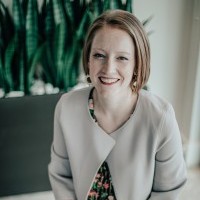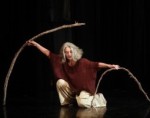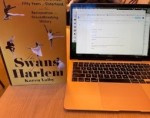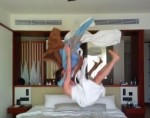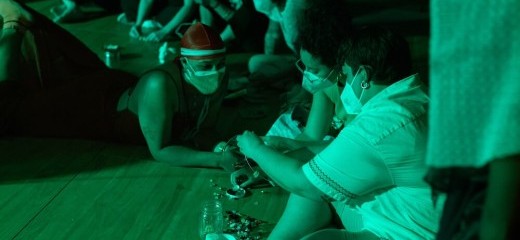
Co-creating softness in community
by Ellen Miller
Mawu Ama Ma’at G. Oyesii has been doing hard work for most of their life. Classically trained, they define their training as untraditional, as in: unlike many of their peers, they could afford dance classes. A multi-hyphenate, Mawu’s training spans West African, jazz, hip-hop, and modern. During their time as a dance artist with Zaman Dance Theater in New Jersey, they explored the impact of emotionally charged topics like the Rwandan genocide through dance. This experience shaped both their technical training as well as their artistic lens.
Much of Mawu’s work incorporates political themes. Their thesis in grad school, Project Assata, centered the work of Assata Shakur and explored themes of Black liberation, women freedom fighters, and pedagogies of protest. “My work is about bringing people together where we can be in conversation about politics. That feels important,” they say. “Yes my work is political, but I don’t really feel I have many choices. It is my way of dealing with reality. Art helps us to ground in a moment, to talk about some of the things that are happening, but also has a way of connecting us across race, gender… I have seen the potential of dance from people I have worked with.”
More recently, Mawu has explored the idea of softness through their performance project something soft, which originated as a solo. The second iteration (Mawu is hopeful that more will come) was presented at the Painted Bride in Philadelphia this past April. Recently, I joined Mawu on Zoom to learn more about their experience creating and performing the work.
Ellen Miller: Tell me about how something soft came to be.
Mawu Ama Ma’at G. Oyesii: I think about the innocence of dance that brings people together, the simplicity of it. something soft first was a solo, because I was trying to figure out what I was trying to say. I felt like most of my career has been about really heavy political work like genocide and I’ve not really given myself permission [to], or maybe I didn’t think I could, talk about things that were just about what I was experiencing.
I always felt a responsibility to my people, probably because of the way I was raised, to just put those things forward. So this work felt like I was giving myself permission to make a different choice about what I was talking about.
In this first iteration of something soft…I asked myself, “What is going on with my artistic practice? How do I make? How do I want to make?” Because my process has tended to be very exhausting and hard on my body to be embodying these people’s struggles all the time. This work felt like I was giving myself permission to ask myself “What is my practice with making art?” And not in a way that is painful… and wanting the water, because I feel like I had been in the fire.
Mawu was raised in a Pan-African household where their family studied traditional African spirituality.
MG: I always felt growing up I had another life, and asking myself what softness was for me was inviting all of myself into the room.
Mawu realized they needed the support of others to bring something soft into being. They point to their collaborators and the contributions they added to the work: Jah brought in Kevin Quashie, Majesty brought in soundscape and score, their cousin Hanifa photographed the work, and additional friends joined as movement artists and collaborators.
MG: I talk about moving in community, but how can I move in community even in my practices of how I’m building the work? What are the ancestral practices I can use to find reprieve? This work is in some ways about identity, but identity in a collective. It’s vulnerable. The idea and thoughts really originated in Undrowned, by Alexis Pauline Gumbs. For the first time I feel like I’m seeing this work alive, given breath. The last performance was so powerful.
EM: Did you have a vision for what the end product of something soft would look like, or were you just along for the journey?
MG: A little of both. I think the biggest thing I learned was my deep resistance to pivoting (laughs). I was so angry having to take something out. The classic training, choreography – you know, 5-6-7-8, we’re going to make steps – I didn’t do that this time because, [for example] like Jah is a performance artist but is not a movement practitioner in the same way that I am, so I had to adjust.
When we first did it at Fringe, we had like 8 things on the score, including “Rock the Boat,” which was a somatic exercise where you stay in a rhythm of rocking. It was so cool because sometimes you’d have people in their seats swaying, and some nights the entire audience would be on the floor swaying, and other times we had a mix. I felt like the audience built the architecture, and that influenced what we did when we went to the Bride.
When we moved to the Bride, we had the whole space so we started shifting things, breaking things apart. What are introverts going to do? Oh, I’m going to have a collage corner for them, perfect! And so many people made so many beautiful things. I think that was the most amazing thing about this iteration, was the things people made.
Getting to that appreciation was a process… at first I was like ‘this was not the plan.’ But the pivots ended up meaning I could rest more.
Even when focusing on softness, the piece offered opportunities for activism; one of the set pieces was an altar for Palestine, including a QR code where attendees could learn how to take action.
MG: At the Bride we realized we needed more interactive things, and I wanted to bring in my altar-making work. When I lived in Costa Rica for eight months, I was making all of these altars with people. We would get together at the beach, bringing fruit for people to eat and always saving something for the ancestors. Jah and I foraged; we would go on walks and find things that we felt called to us. I would task myself during the walks, to talk to every person I saw or to find something… Sometimes I would walk for hours, but then it would happen and I would be like, this is magic. So bringing that into the work as well, because while so much is taken, so much was offered.
EM: I feel like you got to embody and experience this iteration of something soft in a way that maybe you didn’t even expect.
MG: It felt like it was also for me. It’s never felt like that in a work - I’ve always been like, this is for the people. This is for the people who are going to come watch me, and [something soft] didn’t feel like an exhibition. It felt like we were in a portal together and we all consented to be there. There was one performance where the audience helped us set up. It was just so wonderful because it wasn’t the thing I’m conditioned to see this as. What does it mean for this to be a ritual? It means we ask for help. It means that the people that came to be a part of this are willing to help. Because we’re all sharing energy.
This interview has been edited for length and clarity.
something soft, Painted Bride Arts Center & other venues, April 6-28, 2024.
By Ellen Miller
August 1, 2024

